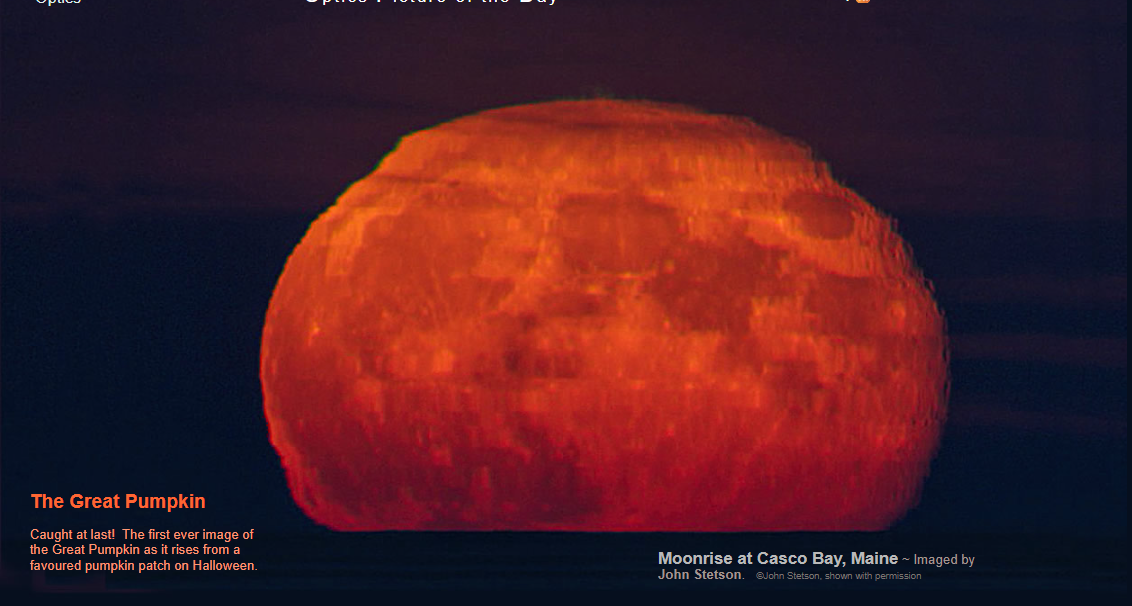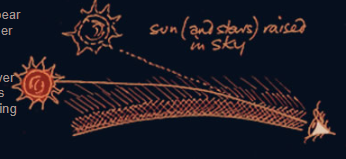The Great Pumpkin, 1st picture - OPOD
The Great Pumpkin: A Captivating Atmospheric Phenomenon
Every year on Halloween, an enchanting event takes place in the night sky: the rise of the Great Pumpkin. This elusive celestial spectacle has recently been captured in the first-ever image by John Stetson in Casco Bay, Maine. The photograph reveals a flattened and reddened moon, appearing as if it has been stepped into several layers. This captivating sight is a result of various atmospheric phenomena that affect the way we perceive celestial bodies.
Flattening and Reddening of the Moon
The moon's peculiar shape in the image can be attributed to ordinary atmospheric refraction. As light from the moon passes through Earth's atmosphere, it encounters variations in air density. The density of the atmosphere increases closer to the ground, causing the low moon rays to be deflected downwards. This deflection creates the illusion that the rays are coming from a higher point in the sky, resulting in an elevated image of the sun or moon.
The lower portion of the moon is affected most by this refraction, giving it a squashed appearance akin to a pumpkin. However, the atmosphere is never entirely ordinary, leading to additional factors that contribute to the moon's unique shape.
Atmospheric Anomalies and Stepped Appearance
In addition to ordinary refraction, variations in temperature within different layers of the atmosphere can cause further distortions. Temperature inversions, where layers of air have different temperatures, play a significant role in creating the stepped appearance seen in the image of the Great Pumpkin. These temperature variations cause additional refractions, further distorting the moon's shape.
Under more extreme conditions, such as during mirages, the moon or sun can appear distorted or displaced. In some cases, these atmospheric anomalies can even create mock-mirage green flashes. Although a hint of green can be observed at the upper rim of the moon in the image, it is more of a green rim than a green flash.
The Vigil for the Great Pumpkin
The fascination with the Great Pumpkin extends beyond atmospheric optics. In the beloved comic strip "Peanuts" by Charles M. Schulz, the character Linus faithfully waits in a pumpkin patch every Halloween night, anticipating the arrival of the Great Pumpkin. Linus firmly believes that the Great Pumpkin will rise from the most sincere pumpkin patch, bringing joy and gifts to those who wait patiently.
However, as depicted in the comic strip, Linus's unwavering vigil is met with skepticism from his friend Charlie Brown. Despite the doubt, Linus remains resolute in his belief, showing unwavering dedication and loyalty to the mythical creature.
The Magic of the Great Pumpkin
The legend of the Great Pumpkin and its association with Halloween captures the imagination of both children and adults alike. It represents a sense of wonder and belief in the extraordinary. While the atmospheric optics behind the moon's peculiar shape add a scientific explanation to this phenomenon, it does not diminish the enchantment and intrigue surrounding the Great Pumpkin.
As we gaze upon the captivating image of the Great Pumpkin rising from the pumpkin patch, we are reminded of the vast complexities of our atmosphere and its ability to create breathtaking visual displays. This unique combination of science and folklore serves as a reminder of the beauty that surrounds us and the mysteries that lie within our natural world.
In conclusion, the first-ever image of the Great Pumpkin provides a glimpse into the captivating world of atmospheric optics. Through a combination of ordinary refraction and atmospheric anomalies, the moon takes on a flattened and stepped appearance, resembling a pumpkin. The legend of the Great Pumpkin further adds to the allure of this phenomenon, captivating our imaginations and reminding us of the magic that exists in our everyday experiences. So, this Halloween, take a moment to look up at the night sky and let your mind wander in awe of the wonders that await us.

The Great Pumpkin
Caught at last! The first ever image of the Great Pumpkin as it rises from a favoured pumpkin patch on Halloween.
Moonrise at Casco Bay, Maine ~ Imaged by John Stetson. ©John Stetson, shown with permission
A flattened and reddened moon rises from the Atlantic Ocean. Its top is stepped into several layers.
Ordinary atmospheric refraction causes the flattening. Earth�s atmosphere increases in density nearer the ground. Low moon or sun rays penetrating into the ever more dense air are deflected (refracted) downwards.
The rays then appear to come from higher in the sky � the sun�s image is raised up. The lower part of the moon is raised most resulting in the squashed pumpkin shape.
But the atmosphere is never quite ordinary or normal. Air layers at different temperature, particularly in temperature inversions, cause further refractions to give the stepped appearance. When they are more extreme the moon or sun is miraged. More extreme still and we see mock-mirage green flashes. There is green at the moon's upper rim in the top image but that is more green rim than green flash.

The vigil for the Great Pumpkin
Linus is sitting out all Halloween night in his pumpkin patch. He does this every year. This time the Great Pumpkin will surely visit him. �Each year the Great Pumpkin rises out of the pumpkin patch that he thinks is most sincere�
Charlie Brown who is passing by. �I got a whole bag of stuff. Do you want an apple?�
Linus. �Thank you.. If the Great Pumpkin comes I�ll put in a good word for you.
Charlie Brown. �if ?�
Linus. �.. I meant when.�
Linus � by now desolate � ..I�m doomed! One little slip like that can cause the Great Pumpkin to pass you by!� - Peanuts by Charles M Schulz.
It's the Great Pumpkin, Charlie Brown
Note: this article has been automatically converted from the old site and may not appear as intended. You can find the original article here.
Reference Atmospheric Optics
If you use any of the definitions, information, or data presented on Atmospheric Optics, please copy the link or reference below to properly credit us as the reference source. Thank you!
-
<a href="https://atoptics.co.uk/blog/the-great-pumpkin-1st-picture-opod/">The Great Pumpkin, 1st picture - OPOD</a>
-
"The Great Pumpkin, 1st picture - OPOD". Atmospheric Optics. Accessed on April 19, 2024. https://atoptics.co.uk/blog/the-great-pumpkin-1st-picture-opod/.
-
"The Great Pumpkin, 1st picture - OPOD". Atmospheric Optics, https://atoptics.co.uk/blog/the-great-pumpkin-1st-picture-opod/. Accessed 19 April, 2024
-
The Great Pumpkin, 1st picture - OPOD. Atmospheric Optics. Retrieved from https://atoptics.co.uk/blog/the-great-pumpkin-1st-picture-opod/.